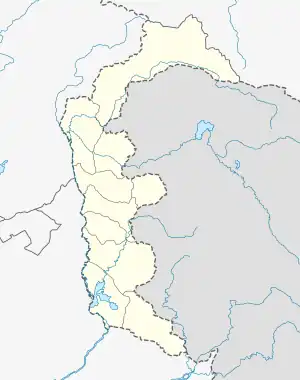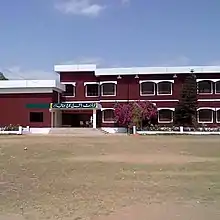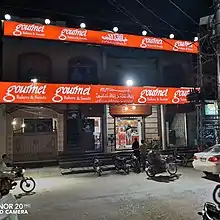Barnala, Azad Kashmir
Barnala (Urdu: برنالہ ) is a city located in the state of Azad Jammu & Kashmir, Pakistan.
Barnala
برنالہ | |
|---|---|
City | |
 Barnala  Barnala | |
| Coordinates: 32°52′14″N 74°14′51″E | |
| Country | Pakistan |
| Territory | Azad Kashmir |
| District | Bhimber |
| Established | 1996 |
| Elevation | 313 m (1,027 ft) |
| Population (2020)[1] | |
| • Total | 150,000 |
| Time zone | UTC+5 (PST) |
| Postal code | 10020 |
| Dialling code | 0092-05828 |
| Website | Official Website |
The word "Barnala" literally translates to Bar (Edge) and Nala (River), which means "on the edge of a river" and was a key location during the 1965 Battle of Chamb.
It serves as a tehsil (sub-division) of the district Bhimber, Azad Jammu & Kashmir.
Gujjar Community is dominating in City and Surroundings and there are also number of Jatts Villages, Rajput Villages and Awan Villages under Tehsil.
According to Census 2017 92% Population Speak Punjabi, 5% Pahari and 3% Urdu in Tehsil Barnala. Pahari Dialect is Spoken in Hilly Areas of Thub, Patni and Villages near LOC.
History
Historically Barnala was part of Punjab and part of Gujrat, Pakistan. According to some historians it became part of kashmir in late 1880s.
Barnala was key location in battle of 1965 in which Pak Army take over Chamb which is also known as Iftikhar Abad.
Geography
Barnala is located on the bank of the Chenab River tributary and is 43.9 km (via Awan Sharif-Fatehpur Road) northeast of Gujrat District of the Punjab Province in Pakistan.
The boundaries of Barnala are connected with Bhimber, Kotla Arab Ali Khan, Gujrat, Sialkot, and Jammu. It is 200 km southeast of Rawalpindi, 180 km southeast of Islamabad, 60 km northwest of Sialkot, and 100 km northwest of Jammu.
Topography
Topographically, Barnala is divided into four regions:
- Plain Region
- Mountain Region
- Hill Region
- Cliff Region
Demography
As per the 2017 Census of Pakistan,[2] the total population of the sub-division Barnala is approximately 137,629 (Projected in 2018 as 140,059). The population annual growth rate[3] is nearly 1.7% with an average household size of 6.7.
Education

The area is divided into remote villages having schools up to primary education level mostly. After primary education majority of the students have to travel a certain distance to study at colleges. The literacy rate of tehsil Barnala was nearly 75% in 2017-2018 (as AJ & K Literacy rate in 2017-2018 was 76.80%). There are several colleges located in and around the sub-division.
Economy
Farming is the primary profession of the people as the area holds fertile land with both rain-fed and tube-well irrigated land. A portion of the young workforce is working abroad the country mainly in Gulf Countries and also across Europe including the entire globe. Business markets operate in the daytime and are almost closed before sunset. The area is known for its mango trees(commonly called desi mangoes دیسی آم) pine trees (صنوبر ،چیڑھ ) along with the cultivation and production of jujube (Beir: بیر ), mulberries(شہتوت), rice, sugar cane, mustard, millet, and wheat.[4] Fine and coarse aggregate materials (sand and crush) are also produced for use in the construction industry. Stone dust, also known as Khaka, is used in place of sand for the construction of temporary units and back-filling. Timber is also produced by this city.
Tourism
Pattni vale is a beautiful viewpoint for tourists and is situated near the LoC (Line of Control). Panjj Peer Darbar of village Amgah is a place that is mostly visited by Zaireen (Urdu: زائرین ) during Eid. The Mango Gardens of Watala, a historical site in Barnala, also attracts a wide range of tourists. Peer Monga Darbar is a place visited by Zaireen (Urdu: زائرین ) on a daily basis.
Landmarks

The central mosque of the city is the Bilal Masjid, while Muhammadi Masjid lies in the southeastern part of the city. The Barkat Plaza is the central shopping mall and is located on one of the main roads of the city. The Inter College for Boys Library and Girls Degree College are located in southwest Barnala.[5] A small park called the Barnala Qabaristan is in the northwest regions whereas Kot Jamel road leads across a bridge over the Chenab tributary to the eastern parts of the city. The eastern side of the city is also home to the Government Boys Degree College, Masjid Ahl-e-Hadis mosque, and the Tawaqal Sanitary.MD colony(dhinganwalli)located almost 12 km far from barnala.[6]
Union Councils
Tehsil Barnala consists of the following 7 union councils:
- Barnala
- Pattni
- Pangali
- Watala
- Malot
- North Iftikharabad (Chamb)
- South Iftikharabad (Chamb)
- Ambriyala
References
- "Statistical Year Book 2019" (PDF). Statistics Azad Jammu and Kashmir. Retrieved 4 May 2020.
- "Pakistan - Census, Standards & Statistics". doi:10.1163/2213-2996_flg_com_323859.
{{cite journal}}: Cite journal requires|journal=(help) - "Statistical Year Book 2019". International Year Book and Statesmen's Who's Who. Archived from the original on 3 December 2017. Retrieved 11 May 2020.
- Indian and Foreign Review - Volume 15 (1977), p. 12.
- Directory of Libraries in Pakistan (1996), p.3
- Google. "Barnala, Azad Kashmir" (Map). Google Maps. Google. No URL entered.